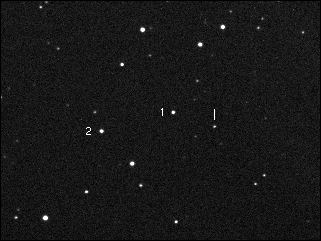
215 images obtained during the night from 20:30 till 4:15 UT (almost 8 hour interval), exposition 60 s, unfiltered, auto-dark, flatfield correction (no other), an aperture photometry performed by Munipack software yielded 198 lightcurve points. The apparent magnitude of (2953) Vyshleslavia is approximately 15.8 mag.
The first fig. 1 shows a CCD image of the asteriod (2953) Vysheslavia and its slow motion. On fig. 2 you could see a raw relative lightcurve (asteroid - comparsion star) with error bars, the averaged lighcurve is displayed on fig. 3. We performed several test of our photometric measurements: different apertures (fig. 4), another comparsion star (fig. 5). Fig. 6 depitcs the differences between the comparsion stars and demostrates the precision of photometry about 0.04 mag. Click on figures 2 - 6 to get EPS format.
The peak on the lightcurve around 0:40 UT = 51549.025 JD is caused by a passage of the asteroid near by 17 magnitude star (denoted by a vertical dashed line on fig. 2).
Amplitude of the brightness changes is smaller than 0.2 mag, but seems to be at least 0.1 mag.
Rotational period of the asteroid estimated from lightcurves seems to be roughly 3.5 hour.

Fig. 1 - CCD image of the asteroid (2953) Vysheslavia.
At 21:50 UT the position of the asteroid was RA =
8h
22m,
DE = 18° 14', in constellation Cancer.
North is up, east is left, filed of view is appromately 10×8 arcmin.
The numbers 1 and 2 denotes comparsion stars
GSC 1382-0459 and GSC 1382-0222, the asteroid itself
is marked by a short white line.
You could see GIF animation [219 kB] of an asteroid
motion during 5 hours (20:34 - 1:15 UT).
Fig. 2 - Relative lightcurve of (2953) Vysheslavia (asteroid -
comparsion star). The comparsion star was GSC 1382-0459 (14.46 mag).
The vertical dashed line denotes the time of the asteroid passage along
a 17 magnitude star. This passage yielded to a peak on the lighcurve,
which could be clearly seen also on fig. 4.
Fig. 3 - Original data points and averaged lightcurves
of (2953) Vyshleslavia. The same comparsion star as in
fig. 2. The data points, when the asteroid passed along
a star, are removed.
Fig. 4 - Three lightcurves of (2953) Vysheslavia using
three different photometric apertures - radii 2.0, 2.7 and 3.8.
The resonable difference could be seen around JD = 51549.025,
when the astoroid passed near a star. The larger aperture
the more amount of stars light was included into the photometric box
and the asteroid seems brigher.
Fig. 5 - Lightcurvers of (2953) Vysheslavia with two
different comparsion stars: GSC 1382-0459 (14.46 mag) and GSC 1382-0222
(14.08 mag). The lightcurves were aligned for the comparsion
(their averages were set to 0). No significant difference exceeding
0.05 mag is noticable.
Fig. 6 - The difference between the two comparsion stars
(and subtracted the average of all data points). A little bit higher
scatter of data points after JD = 51549.05 could be produced
by hasy clouds passing over the observatory.
However, the rough presicision of our photometry seems to be 0.04 mag
(for 15 mag objects).
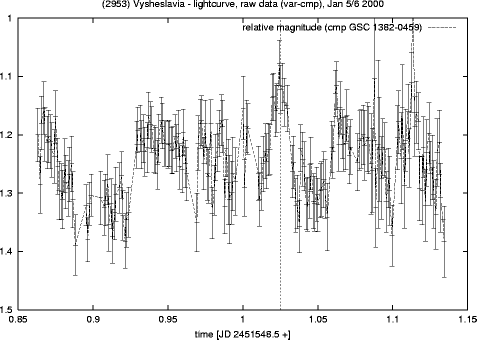
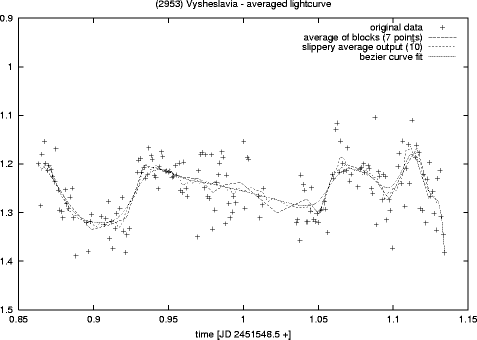
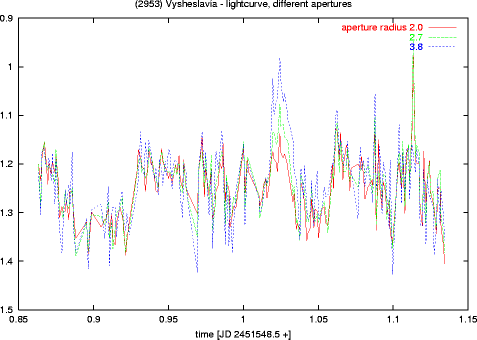
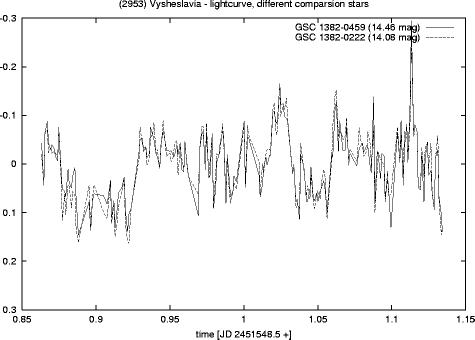
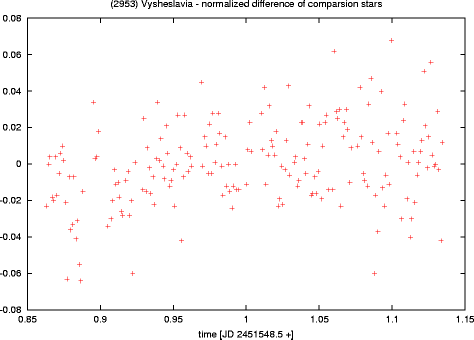
Miroslav Broz,
miroslav.broz@email.cz,
Jan 7th 2000